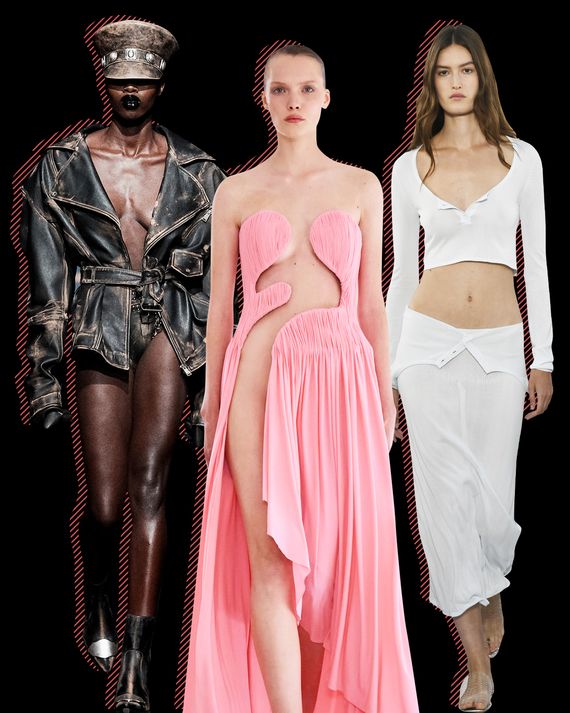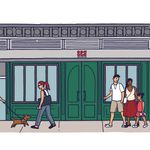
When a French house decides to cross the pond for New York Fashion Week and show its collection in the spiral of the Guggenheim Museum, everything must be right. Nobody wants to look up that famous rotunda and see logos marching down the ramp or, for that matter, navy blazers and khakis. Although the Guggenheim once held a fashion exhibition for Giorgio Armani — and came under heavy criticism — it has never allowed a runway show, until last night. So an aesthetic connection between the clothing designs and Frank Lloyd Wright’s masterpiece mattered.
Pieter Mulier, the creative director of Alaïa for the past three years, was also ready for this spectacular stage and before an intimate crowd of 200 guests that included many close friends of the late Azzedine Alaïa, among them Peter Brant and Stephanie Seymour; Linda Evangelista and Naomi Campbell. (Rihanna, in Alaïa, made her usual late entrance.) Azzedine Alaïa had a huge circle of friends, including artists like Andy Warhol and Julien Schnabel, politicians, writers, photographers like Jean-Paul Goude, and entertainers like Grace Jones. New York in the 1980s helped establish his reputation as a modern couturier, first with two big shows in the city and then the designer’s first boutique, in SoHo. The designer always collected the work of American designers, notably Adrian, Claire McCardell and Charles James.
At his previous show, in Paris, in January, Mulier made a collection from a single fiber, merino wool. It was an extraordinary exercise in restraint and produced by far his best designs for Alaia — draped balloon trousers, sheer knits, plush coats that looked amazingly like shearling, and a white dress that spiraled down the body, leaving skin exposed. It was Alaia but now with Mulier’s personal stamp. “It’s moving on,” he said at the time. “I mean, we did va-va-voom for two and a half years. ” Indeed, six months before, he was showing lots of latex and leather. And buttons — suits and coats excessively adorned with buttons.
On Friday night, the clothes were made without zippers and buttons, and he continued to develop those fluid harem-style pants, sometimes with a kind of fluttery peplum. They’re going to be copied left and right. The fuzzy coats now have a spiral pattern, and he expanded upon the spiral dress; they have built-in elements in the panels that help the design mold to the body. There were also a number of deeply channeled and curved puffer jackets that made me think of the glamorous satin interiors of a Golden Age Hollywood movie. Early in his career, as a young Tunisian living in Paris and learning his craft (while working as a nanny for one of his rich clients), Alaïa was deeply influenced by Hollywood films.
In so many ways — most of them subtle — Mulier referenced American fashion, from the practical designs of its sportswear innovators like McCardell to its sleek sensualists like Halston. There were, apparently, nods to James Galanos, the California designer; and I wondered if a chic, plain white mini dress was somehow inspired by a more ladylike version from Pauline Trigère. Over the decades, many New York designers have loved to eliminate zips and buttons, few as distinctively as Zoran.
The point is that Mulier, who spent several years working with Raf Simons at Calvin Klein and who collects fashion himself, found a fresh way to see American clothing design and then brought a solid Parisian couture hand to it. That is the outstanding difference, which is why the Guggenheim’s radical spiral made complete sense for this show.
I might also add that with his last two collections, Mulier now seems to have Alaïa at his fingertips, so that the clothes feel right and new but also second-nature.
Most New York brands don’t have Alaia’s resources (and it’s a relatively small company, owned by Richemont, in the luxury field) or Mulier’s unique sense of distance from American culture.
Looking at Brandon Maxwell’s show, on Friday, I thought, God, what this guy could do with the money and structure of a major brand behind him. The collection was one of his best in ages, in part because he drew so smartly on sportswear and then gave it a sexy pull. His style used to be so fiendishly done up, and it was fun for a while but it lost contact with the world. As Maxwell said in his show note, “I’ve softly unraveled the brand DNA to create garments that foster a sense of calm and confident nonchalance.”
And how. It came across in fine ribbed tops or slim dresses layered over a tank or a tube skirt, sometimes with a spill of tendril-like ruffles at the hem. Or an opaque blazer in pure white with trousers. His evening looks—it’s hard to actually call them “evening”—were just as compelling and featured a pale pink satin dress with a slim skirt and a soft halter top.
Hillary Taymour called her modest Collina Strada show “Touch Grass,” she opened with a woman doing handsprings on the lawn of a park in the East Village and ended with a guy pushing a hand mower past the audience. Taymour clearly trusts her intuition. She didn’t break new ground but stuck with her blurry prints, loading up the celestial blues and broken-looking slips and frilly tops. And it all still charmed me, perhaps for not trying too hard. Taymour added a new line of mesh boots with thick soles. They’ll cost around $200.
It’s the 10th anniversary of Area, the independent label headed by Piotrek Panszczyk. There was so much to admire in this collection — above all, the exceptional leather pieces that looked distressed; the denim garments woven (or, perhaps, printed) with ghostly white hand prints or fragments; the oversized military tailoring and a superb black leather mini dress embroidered with thousands of quill-shaped beads so that the result looked like a pelt of frosted fur.
Yet I wasn’t all that moved by the show, though I wanted to be. I very much like Panszczyk’s vague references to 1980s European fashion (or so I saw), to a kind of political darkness that also feels relevant today and was expressed, in part, with his extreme police-style caps and, of course, the hand motifs. But, in his semi-dark space, he just didn’t make his point as clear as he needed to.















